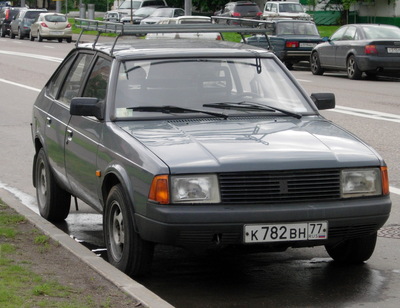
Moskvitch 2141—a common late-Soviet-period car.
By the end of the Second World War, more substantial progress had been made in road construction, largely due to the use of Gulag prisoners (starting before the war) as well as prisoners of war. Indeed, some POWs were held until well after the end of the war and used to provide labor for various infrastructure construction projects. These as well as so-called labor obligations imposed upon local populations, largely during collectivization, slowly improved the state of Russian roads until using them as a transportation network was quite viable. Still, through the demise of the Soviet Union, roads continued to be a major sticking point for drivers. (Siegelbaum 138-172)
This, plus the uptick in automobile production, however, were not much help to the average Soviet citizen looking to purchase a car, as the majority of vehicles were state-owned from around the time of the First World War. In keeping with official Soviet ideology, state-owned cars were not meant to be used for private errands by the officials they were assigned to; perhaps unsurprisingly, however, this regulation seems seldom to have been enforced. Furthermore, due to the high utility and prestige of having a car, firms and officials were willing to influence their distribution in exchange for political favors. That is to say, they formed a certain type of political currency, facilitating illicit exchanges between different sources of political power. (Siegelbaum 181–193)
However, these cars being traded as political pawns had yet another advantage over the average citizen looking to become a driver: they were accompanied by chauffeurs. This was a huge advantage in the car-unfriendly Moscow (and even more so in smaller cities), as service stations were few and far between, weather conditions harsh, Russian automobiles fiendishly unreliable, and Russian drivers often cavalier about unsafe driving habits. Indeed, one of the major problems faced was that of drunk driving: a series of posters were commissioned to warn of the dangers of doing so, but the number of fatalities caused continued to rise. (Siegelbaum 194–198)
With an aim to increase production to meet increasing demand, the Volzhsky Avtomobil'ny Zavod (Volga Automobile Plant) (VAZ) was constructed c. 1966, in a newly-created factory town, Tol'yatti (named after Palmiro Togliatti, secretary of the Italian Communist Party). The plant started production in 1974, slowly ramping up to a production near projections, despite housing shortages, occasional strikes, and other various problems. Their initial production run was of the Fiat 125, due to a production deal reached with the manufacturer. Nevertheless, the factory went on to produce some of the most iconic Russian cars, including the Zaprozhets. (Siegelbaum 80–116)
Even with more plentiful cars available, however, many problems still faced the prospective driver. Gasoline was difficult to find, much less any replacement parts that might be needed. This latter point was exacerbated by the fact that cars were often shipped missing parts or with defective parts, in an attempt by auto manufacturers to meet quotas. Thus, a black market for both gasoline and auto parts quickly developed, with both fetching premium prices. Moreover, finding a place in Moscow or other cities to park a car was not easy; there was little official recognition of this need, so patchwork garages were constructed in a disorganized fashion, often prompting the ire others due to their deleterious effect on the cityscape. (Siegelbaum 229–243)
Furthermore, those possessing automobiles were treated with suspicion from the society at large, at least in part due to the uneasy fit between Soviet ideology and personal cars. In the official Communist ideology, private property was to be abolished; therefore, cars were personal but not private. That is to say, they were not considered property, and could not, for instance, be given to one's heirs upon one's death (although doubtlessly many such arrangements took place without the Soviet state's knowledge). Moreover, the use of private cars to offer rides to others in exchange for money was frowned upon, as a driver doing so was effectively starting a private enterprise. However, due to the lagging of public transit to catch up with increased urban population, such private taxis were generally tolerated, and widely used. (Siegelbaum 232–237)
By the end of the Soviet period, the nature of car ownership had been fairly well established as a potential activity for a citizen, but not necessarily a practical one: purchasing a car might cost some 9,000 rubles, which represents five to eight years of working wages (though one must remember that housing and medical costs were heavily subsidized by the state and required less of the Soviet worker's wages). Further, the lack of downtown parking frequently meant that they were only practical for non-work use, still requiring the use of public transit for daily commutes. Nevertheless, it seemed likely that a continuing increase in the use of cars (and the concomitant increase in traffic jams) would occur. (Morton 194–198)